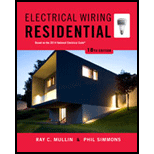
Electrical Wiring Residential
18th Edition
ISBN: 9781285170954
Author: Ray C. Mullin, Phil Simmons
Publisher: Cengage Learning
expand_more
expand_more
format_list_bulleted
Concept explainers
Question
Chapter 21.1, Problem 10R
To determine
State whether the receptacle must be GFCI protected or not when it installed under the kitchen sink for plugging in the food waste disposer.
Expert Solution & Answer
Trending nowThis is a popular solution!

Students have asked these similar questions
Don't use ai to answer I will report you answer
Q1. Consider the unity feedback control system whose open-loop
transfer function is:
G(s) =
=
40(S + 2)
s(s+3)(s + 1)(s + 10)
hod of Ziegler-Nichols.
By using second method of Ziegler- Nichols, calculate the PID, PI-D and
I-PD parameters and make tuning for this
for this parameters to get accepting
response for the following system, then compare your results for all types
controllers?
GIN
1) Use the method of source transformation to find Ix in the following circuit.
ΖΩ j4Ω
wwwm
-j20
60/0° V(+
602
www
492
-j30
www
Chapter 21 Solutions
Electrical Wiring Residential
Knowledge Booster
Learn more about
Need a deep-dive on the concept behind this application? Look no further. Learn more about this topic, electrical-engineering and related others by exploring similar questions and additional content below.Similar questions
- Don't use ai to answer I will report you answerarrow_forward3) The sinusoidal voltage source in the following circuit is given by vg = 22.36 cos(5000t + 26.565°) V. Obtain the Thevenin equivalent of the circuit with respect to the terminals a, b. 50 mH Vg 250 Ω 400 nF 50 mH a barrow_forward2) Use the method of source transformation to find Vo in the following circuit. 102 w j30 0.202 10.6 Ω w m ΦΩΣ 10 Ω 40/0° V Vo -j352 -j19arrow_forward
- The distribution function for a random variable X is - F(x) = { 1 − e−²x² x ≥ 0 .Find a) the density function b)the probability x 2 and c) the probability that -3arrow_forward1. Tests of a 10 kVA, 230/2300 V single-phase transformer have yielded the following results: Vacuum test low voltage side: current = 0.45A Po = 70WLow side short circuit test: voltage = 11.6V Pcc = 224.3WDetermine: a. Parameters Rcc and Xcc of the equivalent circuit referring to the secondary.b. Transformer voltage regulation, if feeding a load of 4kVA, fp = 0.75 in delayc. Efficiency if the load is 7kVA, fp = 0.8 inductivearrow_forwardDon't use ai to answer I will report you answerarrow_forwardThe short-circuit test has been carried out on a single-phase transformer of 2500kVA,50kV/10kV, with the following results: 4000V, 50A , 50000 WIt is known that the transformer has a vacuum current equal to 2% and its efficiency at full load fp=1 is 97.5%. Calculate: A. Parameters of the excitation branch. Rfe, JXm, Pob. Relative voltage drops. εcc, εrcc, εxccarrow_forwardMagnetic Field Analysis of a Helical Coil In this lab you will analyse the inductive coil structure shown in Figure 1. It comprises a solid round copper wire of radius a = 0.8mm, wound into a cylindrical spiral having N = 20 turns, major radius R = 10mm and an axial pitch p = 2mm. The coil is excited by a dc current of 1A. R P 1 (a) Analytic Calculations Figure 1: Helical Air-cored Coil Using the expressions developed in the class, estimate the magnetic flux density B at the centre of the coil. Recall from EN1216 that for a long solenoid, the flux density is given by: HONI B l As we saw in the class (see section 4) a modified expression can also be derived that eliminates the need for the 'long' solenoid assumption: R α1 Р â B = HONI 2l (cosa₂-cosα1) 1 Compare the results obtained using equations (1) and (2) and state which solution you would expect to give the best approximation to the real coil behaviour.arrow_forwardI need immediate help with my SIMULINK model. I don't know why but no matter how much a increase or decrease Kc or TI, the graphs are the same. C'A0(s) is the disturbance going through G'D(s). Please check my transfer function blocks by taking the laplace transform of the equations. Any suggestions is welcome greatly! thanksarrow_forwardP 4.4-22 Determine the values of the node voltages V1, V2, and v3 for the circuit shown in Figure P 4.4-22. 202 ww 4ia 202 w + + ±12 V V₁ ΖΩ V2 ΖΩ V3 11 A + 하arrow_forward3. An inifinite sheet of charge density of 3 nC/m² is located at x=-1m. An infinite line of charge density 1 nC/m is parallel to the the z-axis and intersect the y-axis at y=-1m. (a) What is the electric field vector at (0, 0, 0), assuming & = ε0? (b) What is the region in space where the field is zero?arrow_forwardFind the valve of voltage Vx using SUPERPOSITION 1 M FA www 4 5 M MAA 12V - $10 33 M 23 +x mn 6 8Aarrow_forwardarrow_back_iosSEE MORE QUESTIONSarrow_forward_ios
Recommended textbooks for you
 EBK ELECTRICAL WIRING RESIDENTIALElectrical EngineeringISBN:9781337516549Author:SimmonsPublisher:CENGAGE LEARNING - CONSIGNMENT
EBK ELECTRICAL WIRING RESIDENTIALElectrical EngineeringISBN:9781337516549Author:SimmonsPublisher:CENGAGE LEARNING - CONSIGNMENT

EBK ELECTRICAL WIRING RESIDENTIAL
Electrical Engineering
ISBN:9781337516549
Author:Simmons
Publisher:CENGAGE LEARNING - CONSIGNMENT